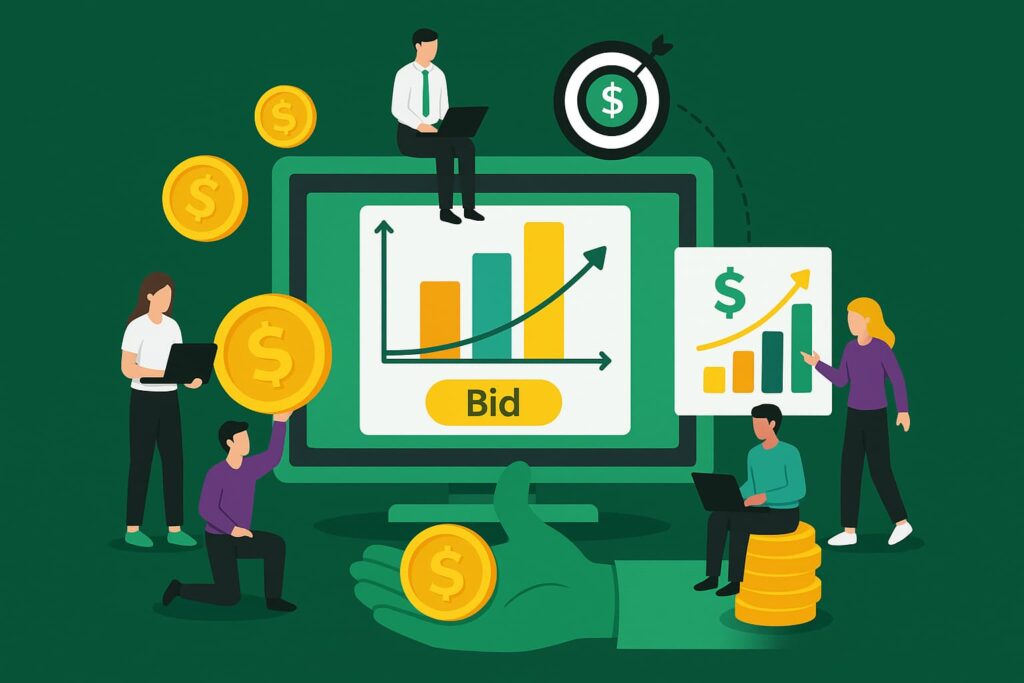Every click costs money in digital advertising. But not every click delivers the same value. That’s why more marketers are asking: how does value-based bidding work, and how can it improve return on ad spend (ROAS)?
Unlike traditional bidding strategies that chase low costs or high volumes, value-based bidding focuses on maximizing the actual business valueof each conversion.
According to Google’s internal data, advertisers who bid based on value can see up to 14% higher conversion value in Searchand as much as 30% more value in Shopping campaigns — all at a similar ROAS.
What Is Value-Based Bidding?
Value-based bidding is an advanced automated bidding strategy where you optimize campaigns not just for conversions, but for the valueof those conversions.
For example, not every customer is worth the same to your business. A $20 order and a $200 order both count as conversions, but one clearly brings more value. VBB ensures that your ad spend prioritizes high-value conversions that drive better revenue outcomes.
In platforms like Google Adsand Meta Ads, advertisers can assign different values to conversion actions, such as purchases, sign-ups, or lead form submissions. The system then uses these values to adjust bids automatically — targeting users most likely to generate the highest return on investment (ROI).
How Value-Based Bidding Works
Value-based bidding runs on a feedback loop powered by machine learning and first-party data. Here’s how it typically works step-by-step:
- Assign Conversion Values:Define how much each conversion is worth to your business. For instance, a completed purchase might be worth $100, while a newsletter signup might be $10.
- Feed Data Into the Platform:Upload this data through tools like Google Ads conversion tracking, enhanced conversions, or CRM integrations.
- Machine Learning Optimization:The platform analyzes signals such as device, location, time, and user behavior to predict which ad auctions will bring in higher-value actions.
- Continuous Learning:Over time, the algorithm refines its predictions, bidding more aggressively on opportunities that historically deliver better value.
This process allows advertisers — and many Sacramento ad agencies— to get smarter over time and align ad spend directly with business goals instead of vanity metrics.
Why Value-Based Bidding Matters
The biggest advantage of VBB is its ability to focus on profitability, not just performance. Instead of optimizing for cost per acquisition (CPA) or click-through rate (CTR), you’re optimizing for return on ad spend (ROAS), a far more strategic metric.
Meta reports that luggage brand Monos achieved a 35% increase in incremental ROASusing Advantage+ Shopping Campaigns powered by value optimization.That’s the kind of efficiency most brands are looking for: smarter spend, stronger results.
Beyond the numbers, value-based bidding improves decision-making. It gives marketers the flexibility to prioritize products, audiences, or customer segments that truly matter, not just those that are easy to convert.
When to Use Value-Based Bidding
Value-based bidding works best when you have:
- A stable flow of conversion data (at least 15–30 conversions per month per campaign).
- The ability to track and assign accurate conversion values.
- A clear understanding of customer lifetime value (CLV).
It’s especially effective for e-commerce, subscription services, and lead-generation campaigns where each conversion can vary in business impact.
However, if your data is limited or inaccurate, the algorithm may optimize in the wrong direction which brings us to the next point.
Common Challenges and Mistakes
While powerful, value-based bidding can fail if the underlying data isn’t reliable. The most common pitfalls include:
- Inaccurate conversion values– overestimating or underestimating value skew optimization.
- Missing offline or CRM data– if your most profitable sales happen offline, make sure that data feeds back into your ad platform.
- Set-it-and-forget-it mindset– VBB still requires monitoring and ongoing adjustments to align with business goals.
A Dun & Bradstreet survey found that 34% of B2B marketers and sales leaderscite inaccurate customer data as a major obstacle to successful data-driven marketing. Clean, complete, and timely data remains the foundation of success.
Best Practices for Implementing Value-Based Bidding
Implementing value-based bidding effectively requires more than just turning on an automated strategy. It’s about building the right data foundation and aligning it with your business goals.
Here are a few best practices that ensure your bidding strategy delivers consistent, measurable results.
- Start Small, Then Scale:Test VBB on a few campaigns or product categories first before expanding across your ad account.
- Prioritize Data Quality:Use enhanced conversions, server-side tracking, or API integrations to ensure your data is consistent and privacy-compliant.
- Regularly Review Conversion Values:Adjust values based on changing margins, inventory, or business priorities.
- Align With Business Metrics:Track Target ROAS and profitability side by side, not just conversion volume.
- Combine With First-Party Data Strategies:As third-party cookies phase out, first-party signals will make your value-based campaigns even more effective.
Conclusion
Value-based bidding isn’t just another algorithmic feature; it’s a strategic mindset. It shifts your focus from getting more clicks to getting more value out of every customer interaction.
As automation and AI continue to evolve, the most successful advertisers will be those who blend technology with strong data discipline. When your bidding strategy aligns with your business goals, every impression has the potential to drive meaningful growth.
Whether you’re managing campaigns in-house or partnering with an experienced business consulting agency in Sacramento for ads management, adopting a value-based approach ensures your marketing spend goes toward results that truly matter.
Ready to maximize the value of every ad dollar? ContactSierra Exclusive today to discover how our team can transform your bidding strategy into a growth engine.
Frequently Asked Questions
How many conversions for value-based bidding?
Value-based bidding works best when a campaign generates at least 15–30 conversions per month per campaign. This amount of data helps the algorithm learn and optimize effectively for higher-value actions. Having more conversions generally leads to more accurate bidding decisions.
Does value-based bidding use AI?
Yes. Value-based bidding uses AI and machine learning to analyze conversion data, user behavior, and contextual signals in real time. This allows the system to automatically adjust bids to maximize overall conversion value instead of just conversion count.
What are two types of value-based smart bidding?
The two main types are Target ROAS (Return on Ad Spend) and Maximize Conversion Value. Both aim to increase the total value generated from your ads, but Target ROAS allows you to set a specific return goal, while Maximize Conversion Value focuses on driving as much value as possible within your budget.
What are the types of value-based pricing?
Value-based pricing can take several forms, but the most common are perceived value pricing, performance-based pricing, and tiered pricing. Each model bases the price on the customer’s perceived or actual value rather than production costs. This approach helps align pricing with customer outcomes and satisfaction.
What are the four smart bidding strategies?
Google’s four main Smart Bidding strategies are Target CPA, Target ROAS, Maximize Conversions, and Maximize Conversion Value. Each uses AI to optimize bids for a specific performance goal. Target ROAS and Maximize Conversion Value are considered value-based strategies.
What is max conversion value bidding strategy?
The Maximize Conversion Value strategy automatically adjusts bids to get the highest total conversion value possible within your budget. It uses AI to prioritize auctions that are more likely to result in high-value actions. This approach is ideal for advertisers focused on overall revenue growth, not just conversion volume.




